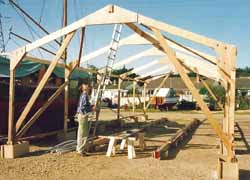Building a Custom Wood-Epoxy Sailboat
The creation of Alacazam, a 38-foot cruising sailboat crafted from wood and epoxy, exemplifies the incredible possibilities available through skilled craftsmanship and innovative building techniques. This article delves into the intricate process of building a wood-epoxy cedar-strip sailboat, illustrating that with proper planning and execution, a complex vessel can evolve into a remarkable achievement.
Table of Contents
Planning is Key
Cedar Strip Boat Building & the Wood-Epoxy Technique
Sheathing the Hull in Woven Glass Rovings
Constructing the Plywood Bulkheads
Assembling the Interior Structure
Deck & Coach Roof Construction
Moulding the GRP Cabin Top
Fitting the Bulb Keel
Creating the Rudder
Years of Dedication
Named after Nat King Cole’s enchanting song “Orange Coloured Sky,” Alacazam boasts impressive specifications:
Length Overall: 11.5m (37.5 feet)
Waterline Length: 10.6m (34.5 feet)
Beam: 3.9m (12.5 feet)
Draft: 2.2m (7 feet)
Displacement: 7,023kg (7.75 tons)
Displacement/Length Ratio: 159
Sail Area/Displacement Ratio: 18.28
Planning is Key
Starting from the ground up, a successful boat-building project deserves meticulous planning. Rather than opting for an old boat refurbishment, the intention was to craft something exquisite and distinct. A thorough examination of the project from inception to completion is crucial to avoid disruptions and additional costs later in the process.
Understanding the relationship between the size and cost of the sailboat is fundamental. When aiming to increase length, the expenditure can rise exponentially. Ownership and operation costs trend similarly, particularly when dockage and maintenance figures come into play. For instance, berthing expenses can spike significantly at 12 meters (40 feet) and continue to do so at 15 meters (50 feet). Hence, the decision to finalize Alacazam’s size at 11.5m (38ft) ensured optimal value.
Defining the Ideal Cruising Sailboat
In reimagining the ideal cruising vessel, knowledge gained from previous sailing expeditions contributed significantly. Having sailed many miles aboard a heavy displacement cruiser, vital characteristics were recognized for the new design. An ideal cruising sailboat would have a cutter rigged sloop design with specific sail attributes, ensuring ease of handling and robust performance.
Key criteria included the following:
Capable of resisting capsize
Robust and low-maintenance
Delivering excellent performance under sail
Providing a comfortable motion while underway
Manageable by a small crew
Ample internal volume for comfortable living
Reasonably affordable for ownership and operation
Recognizing the necessity of expertise, collaboration with yacht designer and shipwright Andrew Simpson initiated the design phase. The vision for Alacazam included a lightweight, quick, and seaworthy vessel that would be both robust and comfortable.
The Construction Phase
To meet unique long-distance sailing requirements, Alacazam demanded a custom approach to design. Constructing an adequate workspace came first—essentially a construction shed—where the magic would unfold. This structure incorporated sturdy timber uprights, practical trusses for support, and effectively crafted wind bracing to ensure stability.
After the shed’s build-out, the next steps encompassed the core aspects of the boat construction:
Cedar Strip Boat Building & the Wood-Epoxy Technique
Cedar strip construction embraced lightweight material properties while offering strength, essential for sailing performance. The wood-epoxy technique ensured durability and weather resistance, vital for seafaring adventures.
Integration of Hull Components
Sheathing the hull required laying woven glass rovings across the wood frame, reinforcing the structure. Precise cutting and installation of plywood bulkheads followed, establishing separate compartments critical for stability and buoyancy.
Assembling the Interior Structure
After that, focus shifted to constructing the interior framework, configuring layout and functional space for a comfortable living experience aboard. The attention to detail ensured that every nook and cranny was planned for optimum utility.
Finalizing the Aesthetics
Constructing the deck and coach roof came next. Elegance supported by practicality defined the finishing touches. Finally, fitting the bulb keel and creating a rudder further enhanced sailing efficiency.
Conclusion and Reflections
Creating Alacazam showcased not just a building project, but a journey into the passion behind sailing and sea exploration. Assembling a wood-epoxy sailboat fits perfectly within the nautical community, offering immense experiences across diverse waterways. This unique venture serves as a profound reminder of the special connection between craftsmanship and navigating the world’s oceans. Planning an ocean escapade? Take full advantage of the opportunity to rent a boat—each inlet and lagoon tells a story as rich as the landscapes they inhabit, making indulging in seaside exploration unforgettable. If you’re setting your sights on your next marine adventure, consider the opportunities with GetBoat.com.
The narrative unfolds a blend of technical prowess and enduring spirit of adventure found in boat creation and sailing. With GetBoat.com guiding the way, exploring diverse coastal landscapes and experiences can become the heart of your travels. Rent a yacht for tranquility, experience hours of oceanic bliss, and allow the sea to chart your unique course forward.

 The Journey of Crafting Alacazam: A Wood-Epoxy Sailboat">
The Journey of Crafting Alacazam: A Wood-Epoxy Sailboat">
